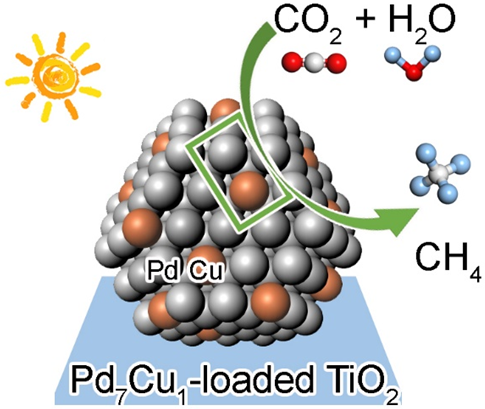Photocatalyst Development for Highly Selective Carbon Dioxide Conversion
A significant increase in atmospheric carbon dioxide levels during the past decades has been widely recognized as a global environment problem. For this reason, a large number of investigations have been performed for the reduction of carbon dioxide. In particular, the photocatalytic conversion of carbon dioxide with water into methane is an appealing approach, which allows the transformation of carbon dioxide into a carbon-neutral fuel by harvesting solar energy. Despite the promising future, this approach has faced a grand challenge in terms of reaction activity and selectivity. Most recently, the research group led by Prof. XIONG Yujie at the University of Science and Technology of China has discovered that the isolation of copper sites in palladium lattice promotes the conversion selectivity of carbon dioxide to methane, based on the lattice engineering on the catalytic sites of photocatalysts. This work has been published in Journal of the American Chemical Society (J. Am. Chem. Soc. DOI: 10.1021/jacs.7b00452).
The activity and selectivity have yet to be significantly improved for two reasons: (1) carbon dioxide molecules possess very low reactivity in chemical transformations, limiting the catalytic activity; and (2) multiple side reactions such as the reduction of carbon dioxide to carbon monoxide and the hydrogen evolution from water reduction simultaneously take place, lowering the reaction selectivity. Previous studies indicate that copper sites exhibit excellent performance in the adsorption and activation of carbon dioxide molecules and thus can serve as catalytic sites integrated with semiconductor photocatalysts. However, the metallic Cu materials at the nanoscale heavily suffer from oxidation, and often provide multiple pathways for catalytic reactions.

To address this grand challenge, Xiong research group has incorporated single-atom copper sites into palladium lattice, which can largely prevent the oxidation of copper sites. Meanwhile, the strong binding of hydrogen to palladium can suppress hydrogen evolution and other side reactions in photocatalytic carbon dioxide conversion. Based on the bimetallic palladium-copper structures, the researchers have further combined synchrotron radiation-based X-ray absorption fine structure spectroscopy characterization, in-situ infrared spectroscopy detection and theoretical simulations to establish the structure-property relationship between catalytic sites and carbon dioxide conversion performance. Taking titania photocatalyst as an example, the conversion selectivity carbon dioxide to methane in photocatalysis achieves 96% by Pd7Cu1-TiO2. This design is also applicable to visible-responsive photocatalysts, which can be implemented in photocatalytic carbon dioxide conversion under visible illumination. This work provides fresh insights into the catalytic site design for selective photocatalytic carbon dioxide conversion, and highlights the importance of catalyst lattice engineering at atomic precision to catalytic performance.
Profs. Li Song, Junfa Zhu, Zeming Qi and Jun Jiang made important contributions to the synchrotron radiation-based X-ray absorption fine structure spectroscopy, photoelectron spectroscopy, in-situ diffuse reflectance infrared Fourier-transform spectroscopy characterizations and theoretical simulations in this work. This work was financially supported by the 973 Program, NSFC and CAS Key Research Program of Frontier Sciences.
Publication link: http://pubs.acs.org/doi/abs/10.1021/jacs.7b00452
Back
